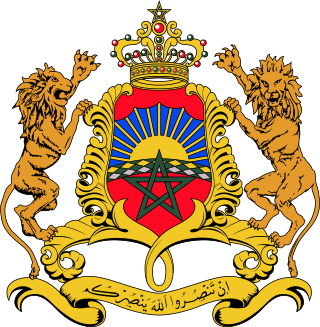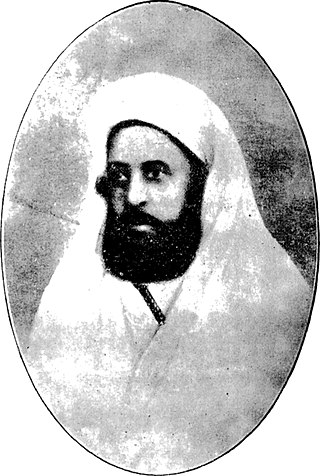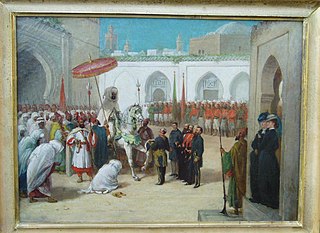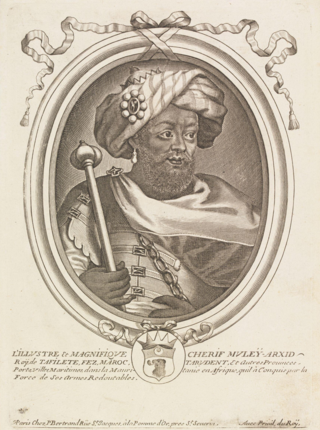
Moulay Ismail Ibn Sharif was a Sultan of Morocco from 1672 to 1727, as the second ruler of the 'Alawi dynasty. He was the seventh son of Moulay Sharif and was governor of the province of Fez and the north of Morocco from 1667 until the death of his half-brother, Sultan Moulay Rashid in 1672. He was proclaimed sultan at Fez, but spent several years in conflict with his nephew Moulay Ahmed ben Mehrez, who also claimed the throne, until the latter's death in 1687. Moulay Ismail's 55-year reign is the longest of any sultan of Morocco. During his lifetime, Isma’il amassed a harem of over 500 women with more than 800 confirmed biological children, making him one of the most prodigious fathers in recorded history.

The 'Alawi dynasty – also rendered in English as Alaouite, 'Alawid, or Alawite – is the current Moroccan royal family and reigning dynasty. They are an Arab Sharifian dynasty and claim descent from the Islamic prophet Muhammad through his grandson, Hasan ibn Ali. Their ancestors originally migrated to the Tafilalt region, in present-day Morocco, from Yanbu on the coast of the Hejaz in the 12th or 13th century.

MoulayAbd al-Rahman bin Hisham was Sultan of Morocco from 30 November 1822 to 28 August 1859, as a ruler of the 'Alawi dynasty. He was a son of Moulay Hisham. He was proclaimed sultan in Fes after the death of Moulay Sulayman.

MoulayAbd al-Aziz bin Hassan, born on 24 February 1881 in Marrakesh and died on 10 June 1943 in Tangier, was a sultan of Morocco from 9 June 1894 to 21 August 1908, as a ruler of the 'Alawi dynasty. He was proclaimed sultan at the age of sixteen after the death of his father Hassan I. Moulay Abdelaziz tried to strengthen the central government by implementing a new tax on agriculture and livestock, a measure which was strongly opposed by sections of the society. This in turn led Abdelaziz to mortgage the customs revenues and to borrow heavily from the French, which was met with widespread revolt and a revolution that deposed him in 1908 in favor of his brother Abd al-Hafid.

MawlaySulayman bin Mohammed, born on 28 June 1766 in Tafilalt and died on 28 November 1822 in Marrakesh, was a Sultan of Morocco from 1792 to 1822, as a ruler of the 'Alawi dynasty. He was proclaimed sultan after the death of his half-brother al-Yazid. Sulayman continued his father's centralization and expansion of the kingdom, and most notably ended the piracy that had long operated from Morocco's coast. As part of Morocco's long running conflict with Spain and Portugal, Sulayman halted all trade with Europe. However, he continued his father's policies of close relations with the United States. He was also a follower of Wahhabism.
Sidi Mohammed ben Abdallahal-Khatib, known as Mohammed III, born in 1710 in Fes and died on 9 April 1790 in Meknes, was the Sultan of Morocco from 1757 to 1790 as a member of the 'Alawi dynasty. He was the governor of Marrakesh around 1750. He was also briefly sultan in 1748. He rebuilt many cities after the earthquake of 1755, including Mogador, Casablanca, and Rabat, and Abdallah Laroui described him as "the architect of modern Morocco." He also defeated the French in the Larache expedition in 1765 and expelled the Portuguese from Mazagan (al-Jadīda) in 1769. He is notable for having been the first leader to recognize American independence in his alliance with Luis de Unzaga 'le Conciliateur' through correspondence and Unzaga's secret intelligence service and led by his brothers-in-law Antonio and Matías de Gálvez from the Canary Islands. He was the son of Mawlay Abdallah bin Ismail and his wife a lady of the Chéraga guich tribe.

MawlayHassan bin Mohammed, known as Hassan I, born in 1836 in Fes and died on 9 June 1894 in Tadla, was a sultan of Morocco from 12 September 1873 to 7 June 1894, as a ruler of the 'Alawi dynasty. He was proclaimed sultan after the death of his father Mawlay Muhammad bin Abd al-Rahman. Mawlay Hassan was among the most successful sultans. He increased the power of the makhzen in Morocco and at a time when so much of the rest of Africa was falling under foreign control, he brought in military and administrative reforms to strengthen the regime within its own territory, and he carried out an active military and diplomatic program on the periphery. He died on 9 June 1894 and was succeeded by his son Abd al-Aziz.

MawlayMuhammad bin Abd al-Rahman, known as Muhammad IV, born in Fes in 1803 and died in Marrakesh in 1873, was the Sultan of Morocco from 28 August 1859 to 16 September 1873 as a ruler of the 'Alawi dynasty. He was proclaimed sultan after the death of his father, Abd al-Rahman. His reign marked a series of reform to tackle European influence on Morocco, as Ottoman Algeria had just been conquered by France in 1830, leading to European nations entering military conflicts with Morocco, such as the Battle of Isly with France in 1844 and the Battle of Tetuan with Spain in 1860. He was succeeded by his son Hassan I.

The Saadi Sultanate, also known as the Sharifian Sultanate, was a state which ruled present-day Morocco and parts of Northwest Africa in the 16th and 17th centuries. It was led by the Saadi dynasty, an Arab Sharifian dynasty.

Tuat, or Touat, is a natural region of desert in central Algeria that contains a string of small oases. In the past, the oases were important for caravans crossing the Sahara.

Moulay Al-Rashid ibn Sharif, known as Moulay Al-Rashid or Moulay Rachid, sometimes called Tafiletta by the English, was Sultan of Morocco from 1666 to 1672. He was the son of the founder of the 'Alawi dynasty, Moulay Sharif, who took power in the Tafilalt region in 1631.
Abul Amlak Moulay Sharif ibn 'Ali was an Arab Emir of Tafilalt from 1631 to 1636. He was a sharif whose family claimed to be descended from the Islamic prophet Muhammad through his grandson Hasan. Moulay Sharif is considered to be the founder of the Alaouite Dynasty of Morocco for being the father of Sidi Muhammad, Al-Rashid of Morocco, and Ismail Ibn Sharif.

The Black Guard or ‘Abid al-Bukhari were the corps of black-African slaves and Haratin slave-soldiers assembled by the 'Alawi sultan of Morocco, Isma‘il ibn Sharif. They were called the "Slaves of Bukhari" because Sultan Isma‘il emphasized the importance of the teachings of the famous imam Muhammad al-Bukhari, going so far as to give the leaders of the army copies of his book. This military corps, which was loyal only to the sultan, was one of the pillars of Isma'il's power as he sought to establish a more stable and more absolute authority over Morocco.
Lalla Khanatha bint Bakkar (1668–1754), was one of the wives of Sultan Moulay Ismail, and acted as his de facto First Minister and Secretary. After his death, she remained active in the political governance of Morocco during the unstable situation which followed as the mother of Sultan Moulay Abdallah.

The French conquest of Morocco began with the French Republic occupying the city of Oujda on 29 March 1907. The French launched campaigns against the Sultanate of Morocco which culminated in the signing of the Treaty of Fes and establishment of the French Protectorate in Morocco on 30 March 1912. France later concluded, on the 27th November, the Treaty of Madrid with the Kingdom of Spain which established the Spanish protectorate in Morocco. The French still conducted a series of military operations to pacify rebellions in Morocco until 1934.

The history of Marrakesh, a city in southern Morocco, stretches back nearly a thousand years. The country of Morocco itself is named after it.

The Zawiya Dila'iya, also known as the Zawiyaof Dila and the Dila'iya Sultanate, was a Sufi brotherhood, centred in the Middle Atlas range of Morocco.

Si El Madani El Glaoui, born Madani El Mezouari El Glaoui, nicknamed the faqih was a prominent statesman in Morocco during the late 19th century and early 20th century. He was largely responsible for establishing the Glaoui family's power in the country.

The Sous expedition were a series of military expeditions conducted by Sultan Moulay Hassan of Morocco in the Sous region between 1882 and 1895. As a result of these campaigns, a series of Moroccan posts were established to the south of Agadir: at Tiznit, Kasbah Ba Amrane, Assaka and at Guelmim. In addition to these posts, the more obvious and more commanding points of governmental control, Moulay Hassan also invested with official authority many of the local qaids in southwestern Morocco—such as the Qaid of Oued Noun, Dahman ben Bayruk, and the Qaid of Tazerwalt. An investiture of Moroccan authority was as well accorded to the qaids of the Ait Oussa and the Tajakant.

The Alawi Sultanate, officially known as the Sharifian Sultanate and as the Sultanate of Morocco, was the state ruled by the 'Alawi dynasty over what is now Morocco, from their rise to power in the 1660s to the 1912 Treaty of Fes that marked the start of the French protectorate.

















